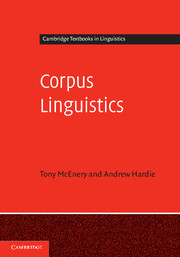Book contents
- Frontmatter
- Contents
- List of figures
- List of tables
- Acknowledgements
- Preface
- 1 What is corpus linguistics?
- 2 Accessing and analysing corpus data
- 3 The web, laws and ethics
- 4 English Corpus Linguistics
- 5 Corpus-based studies of synchronic and diachronic variation
- 6 Neo-Firthian corpus linguistics
- 7 Corpus methods and functionalist linguistics
- 8 The convergence of corpus linguistics, psycholinguistics and functionalist linguistics
- 9 Conclusion
- Glossary
- Notes
- References
- Index
6 - Neo-Firthian corpus linguistics
Published online by Cambridge University Press: 05 June 2012
- Frontmatter
- Contents
- List of figures
- List of tables
- Acknowledgements
- Preface
- 1 What is corpus linguistics?
- 2 Accessing and analysing corpus data
- 3 The web, laws and ethics
- 4 English Corpus Linguistics
- 5 Corpus-based studies of synchronic and diachronic variation
- 6 Neo-Firthian corpus linguistics
- 7 Corpus methods and functionalist linguistics
- 8 The convergence of corpus linguistics, psycholinguistics and functionalist linguistics
- 9 Conclusion
- Glossary
- Notes
- References
- Index
Summary
Introduction
In this chapter, we will explore the approach to corpus linguistics taken by a group of scholars sometimes referred to collectively as neo-Firthian. As this label suggests, these researchers work within the framework of an approach to language suggested by J. R. Firth. The most prominent proponent of the neo-Firthian approach has been John Sinclair. Sinclair was one of the first people to bring Firth's ideas together with a corpus linguistic methodology (as Tognini-Bonelli : 157 points out, Firth himself would probably not have subscribed to corpus methods); and Sinclair played a major role in enabling subsequent work along these lines. Many of the other key scholars in this tradition – including Michael Hoey, Susan Hunston, Bill Louw, Michael Stubbs, Wolfgang Teubert and Elena Tognini-Bonelli – are, or have previously been, associated with the University of Birmingham, where Sinclair was Professor of Modern English Language from 1965 to 2000.
Two central ideas in the approach to corpus linguistics favoured by neo-Firthians are collocation and discourse. It is, then, perhaps unfortunate that these terms are among the most multifariously defined – and, therefore, the most confusing – in all of linguistics. For this reason, in the next two sections we will examine some issues relating to the use of these terms, in theory and in practice. This will include discussion of how these terms are used both generally in linguistics and specifically in neo-Firthian corpus linguistics. Understanding the use of these terms is, to a large extent, key to understanding many of the positions taken by the neo-Firthians.
- Type
- Chapter
- Information
- Corpus LinguisticsMethod, Theory and Practice, pp. 122 - 166Publisher: Cambridge University PressPrint publication year: 2011



